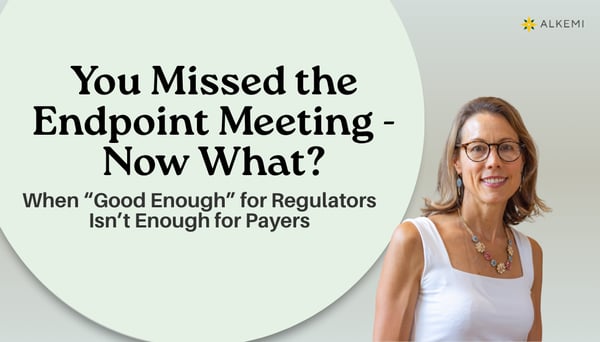Betsy's Note: There's a fine line between pushy and effective. And I’ve learned to dance on it......
You Missed the Endpoint Meeting - Now What?
Betsy's Note: In a perfect world, endpoint selection happens early with payer, patient, and provider input. But most of us live in the real world where decisions get made before all the right people are in the room. The good news? You still have time to shape how the evidence will land.
(3 Min Read)

The regulatory negotiations were a success! The clinical team is off to the races on the Phase III program…
But wait.
No one asked your opinion about the endpoint strategy.
Or maybe you just joined the team, and those decisions were made months ago.
Either way, you’re now tasked with achieving the price and access targets at launch and you see trouble ahead.
The endpoints may satisfy regulators, but you suspect payers will see them as abstract, unfamiliar, or too far removed from the outcomes that matter for reimbursement.
You can already hear the questions:
"What does this measure really tell us about clinical benefit?”
“Does it translate to meaningful change for patients?”
“How does this improve total cost of care?”
Welcome to the “Too Late” moment. But don’t panic... it’s not game over. You just have to make up points before the final exam.
The Course Correction: Make Your Evidence Relevant
You may not be able to redesign the trial, but you can influence how it’s interpreted and extended.
Here’s how to get back on track:
1. Start by Listening - Fast. Engage a few trusted KOLs and payer advisors. Ask how they perceive your trial design, your chosen endpoint, and how that measure translates (or doesn’t) to decision-making in the real world. Their perspective will guide where to focus your energy.
2. Map What You Can Connect. Work with HEOR and RWE partners to see how the primary and secondary endpoints map to quality of life, productivity, or healthcare resource use. Even if payers don’t know the measure today, you can show how it connects to the outcomes they value most.
3. Find or Create Context. Look for data repositories or registries that track similar patients. Could you use real-world data to correlate your endpoint with longer-term clinical outcomes? Even exploratory analyses can build confidence that your signal will translate to real impact.
4. Build the Bridge. Consider pragmatic add-ons: a short patient exit survey, an open-label extension, or a sub-study focused on healthcare utilization. You’re not rewriting the protocol, you’re building the bridge from clinical relevance to payer relevance.
5. Shape the Story Early. Don’t wait for the data to tell its story. Start aligning advocacy leaders, HTA experts, and patient organizations around why this measure matters. If you can’t change the endpoint, change the understanding of the endpoint.
Questions That Drive Course Correction
- How do KOLs and payers perceive the endpoint and its translation to meaningful outcomes?
- Can we model or validate the measure within existing HEOR frameworks?
- What patient-reported or functional data can we layer in?
- Are there opportunities to add exploratory endpoints or long-term follow-up?
- Can we start building real-world evidence on how this measure predicts disease progression or cost?
- What’s the position of guidelines, advocacy groups, or professional societies on this measure’s relevance?
Final Thought
In a perfect world, endpoint selection happens early with payer, patient, and provider input.
But most of us live in the real world where decisions get made before all the right people are in the room.
The good news? You still have time to shape how the evidence will land.
By listening, connecting, and reframing, you can turn an unfamiliar endpoint into a credible story of clinical and economic relevance.
You may have missed the first meeting, but you don’t have to miss your launch goals.
You can still connect your trial measures to the outcomes that matter - for payers, policymakers, and patients. By building the right evidence story, even a technical endpoint can become a powerful proof point of value.
Need help making your endpoints matter or ready to build evidence strategies that never miss the mark again?
That’s what we do best.
Book a call with my team - Schedule a Call
Betsy J. Lahue is CEO of Alkemi, where she helps life sciences companies solve acute value & access challenges and address emerging competitive threats. Her insights on market access and commercialization have guided successful launches across therapeutic areas.
Alkemi - HEOR & Market Access Consulting For Pharmaceutical & Life Sciences Companies
Alkemi helps Pharmaceutical, Biotech, and Medtech leaders:
→ Prove value with clarity and speed
→ Build robust evidence
→ Improve patient access to breakthrough medical treatments
.png?height=200&name=Grey%20White%20Simple%20Professional%20LinkedIn%20Banner%20(4).png)

%20(1).png?height=200&name=Untitled%20(LinkedIn%20Post)%20(1).png)